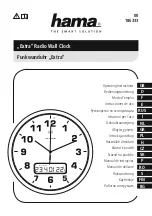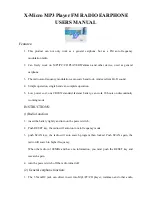
For parameters not set using the DIP switches, use the configuration software to make configuration changes. For parameters set using the DIP
switches, the DIP switch positions override any changes made using the configuration software.
Open the Cover
If the R70SR is in the locked position, the arrow on the cover is above the notch on the base. Follow these steps to unlock and remove the cover.
1. Rotate the cover counter clockwise so that the notches are aligned together.
2. Pull the top cover off.
DIP Switch Settings
Device Settings
DIP Switches
1
2
3
4
Serial baud rate (19200); No parity (software default setting)
OFF
Serial baud rate 9600; No parity
ON
Routed mode (master to slave; repeater/slave to master) (default setting)
OFF
Broadcast mode
ON
Set this radio to be a slave radio (default setting) (900 MHz or 2.4 GHz models)
OFF
OFF
Set this radio to be a master radio
•
900 MHz models: Set to 1 W (30 dBm) transmit power
•
2.4 GHz models: Transmit power remains at 65 mW
OFF
ON
Set this radio to be a repeater radio (900 MHz or 2.4 GHz models)
ON
OFF
Set this radio to be a master radio
•
900 MHz models: Set to 250 mW (24 dBm) transmit power
•
2.4 GHz models: Transmit power remains at 65 mW
ON
ON
Baud Rate and Parity— Use the Baud Rate and Parity setting DIP switches to configure the radio's serial port. These settings must match the device
wired to the radio's serial port. A faster baud rate setting may improve system response time. Changing the baud rate does NOT change the radio
transmission rate. The Software default also provides the ability to set custom baud rate and timing parameter settings via AT commands. For more
information, contact the factory.
Routed Mode—Use routed messaging when using a point-to-point or point-to-point-with-repeater topology. Routing is more robust and faster than
broadcast messaging. In Routed mode, the radios will route serial data packets only to a single device. In general, this mode is for faster
communications. If the Slave/Repeaters are in Routed mode, they will only route serial data packets to the Master and will only listen for serial data
packets coming from the Master. If the Master radio is in Routed mode, it will only route serial data packets to the first Slave radio that comes into
the network. The Master Radio should only be in Routed mode if used in a Point to Point Network.
Broadcast Mode—Broadcast mode allows for more flexible radio layouts and is used in the star and MultiHop tree topologies. These topologies are
much more flexible but they are slower. When using broadcast mode, a small percentage of data packets will not be reach their destination.
Broadcast mode requires the application layer to automatically retry packets that time out. In networks with multiple slaves, the master radio must
use broadcast mode, but the slaves can be set to use routing mode to route their data packets back to the master radio. In Broadcast Mode, the
radios will route serial data packets to all devices in the network. In general, this mode will have slower communication speeds but will allow for
much more system flexibility. If the Slave/Repeaters are in Broadcast mode, they will route serial data packets to all other devices and will listen to
serial data packets coming from all devices. If the Master radio is in Broadcast mode, it will route serial data packets to all Slave/Repeaters and
listen to serial data packets coming from all devices.
Transmit Power Levels—The 900 MHz radios transmit at 1 Watt (30 dBm) or 250 mW (24 dBm). The 250 mW mode reduces the radio's range but
improves the battery life in short range applications. For 2.4 GHz models, this DIP switch is disabled. The transmit power for 2.4 GHz is fixed at
about 65 mW EIRP (18 dBm).
Star Topology—To configure your radios as a star topology, set one radio to be the master in broadcast mode (DIP switch 2 ON). Set all the other
radios to be slaves, also in broadcast mode.
Network Topologies
Cable Replacement Configuration for Point to Point Networks
Figure 2. Simple point to point network
Master
Slave
In this simple cable replacement application, the radio system knows all data originating at one end must be transmitted to the other end. This allows
the radio system to automatically correct for transmission problems and it also provides the greatest throughput. This is the fastest configuration.
• Master configuration route to slave: DIP switches 2 OFF, 3 OFF, 4 ON
• Slave configuration route to master: DIP switches 2 OFF, 3 OFF, 4 OFF
Figure 3. Point to point network with repeater
Master
Slave
Repeater
Sure Cross
®
R70SR Serial Data Radio
2
www.bannerengineering.com - Tel: + 1 888 373 6767
P/N 224673 Rev. B

























